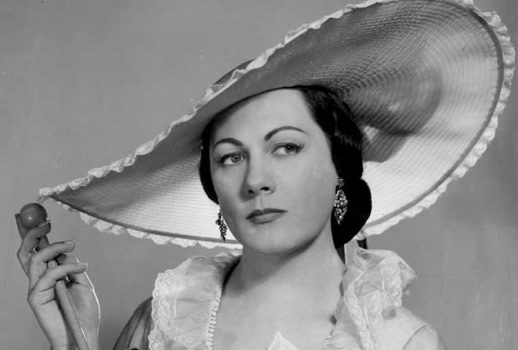

Irving Kolodin in the Saturday Review:
When Miss Tebaldi used her vocal resources thoughtfully and allowed her fine sound to caress the pathetic eloquence of “Dite alla giovine” (Act II) or “Addio del passato” (Act IV), this was singing to charm the ear and delight the mind. When, as too often happened, she turned on the kind of driving, attentuated sound she utilizes for “Aida” or “Andrea Chenier,” it was oversized and slightly irrelevant to this program. Altogether, the second and fourth acts (in this version) were her most successful, for she doesn’t yet command the vivacious spirit or the champagne quality in the voice to make the music dance in the first act “Libiamo” or “Sempra libera.” Even opera goers hardened to the transposition of sundry showpieces flinched at Miss Tebaldi’s unprideful concession to convenience in singing the latter a whole tone down, in G flat rather than A flat. Disregarding the ugly clash of tonalities, it also forced the tenor’s offstage responses into a range disadvantageous for him. What price star system?
As characterization, Tebaldi’s was superficially operatic, suggesting that director Guthrie, an intelligent man as well as a brilliant theatrical mind, realized that making water run uphill would be easier than changing the postures and attitudes which suit Miss Tebaldi, vocally. When she has a driving climax to achieve, the head goes down and the sound tends to be pinched; when the line is flowing easily, the chin is up, the gaze level, the sound beautiful. Guthrie’s most effective work was done in the final scene, where the groupings relative to the dying Violetta were artfully contrived, considering the huge space of her “boudoir” to be filled by four figures.
Rolf Gerard’s sumptuous costumes contributed much to the radiant figure Miss Tebaldi presented from first to last, whether in ball gowns (white with camellias in Act I, dark orange in the gambling scene), country frock, or negligee. Rather than suggesting the hectic flush of a consumptive, the radiance was all Tebaldi’s own healthy beauty, too little dissembled for dramatic purposes, the attitudes and actions too firm and muscular to suggest a wasting disease. Such contradictions are as much a part of the operatic “art” as the prompter’s box, but it could be hoped that a singer of her talents would do as much as such well-remembered Violettas as Bori. Sayao, or Albanese (not to mention Muzio), to make the role convincing. It may happen, but it hasn’t yet.
























Comments